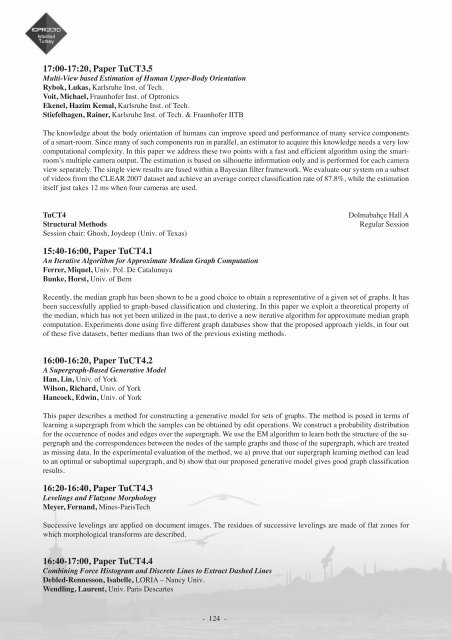Abstract book (pdf) - ICPR 2010
Abstract book (pdf) - ICPR 2010
Abstract book (pdf) - ICPR 2010
- TAGS
- abstract
- icpr
- icpr2010.org
Create successful ePaper yourself
Turn your PDF publications into a flip-book with our unique Google optimized e-Paper software.
17:00-17:20, Paper TuCT3.5<br />
Multi-View based Estimation of Human Upper-Body Orientation<br />
Rybok, Lukas, Karlsruhe Inst. of Tech.<br />
Voit, Michael, Fraunhofer Inst. of Optronics<br />
Ekenel, Hazim Kemal, Karlsruhe Inst. of Tech.<br />
Stiefelhagen, Rainer, Karlsruhe Inst. of Tech. & Fraunhofer IITB<br />
The knowledge about the body orientation of humans can improve speed and performance of many service components<br />
of a smart-room. Since many of such components run in parallel, an estimator to acquire this knowledge needs a very low<br />
computational complexity. In this paper we address these two points with a fast and efficient algorithm using the smartroom’s<br />
multiple camera output. The estimation is based on silhouette information only and is performed for each camera<br />
view separately. The single view results are fused within a Bayesian filter framework. We evaluate our system on a subset<br />
of videos from the CLEAR 2007 dataset and achieve an average correct classification rate of 87.8%, while the estimation<br />
itself just takes 12 ms when four cameras are used.<br />
TuCT4 Dolmabahçe Hall A<br />
Structural Methods Regular Session<br />
Session chair: Ghosh, Joydeep (Univ. of Texas)<br />
15:40-16:00, Paper TuCT4.1<br />
An Iterative Algorithm for Approximate Median Graph Computation<br />
Ferrer, Miquel, Univ. Pol. De Catalunuya<br />
Bunke, Horst, Univ. of Bern<br />
Recently, the median graph has been shown to be a good choice to obtain a representative of a given set of graphs. It has<br />
been successfully applied to graph-based classification and clustering. In this paper we exploit a theoretical property of<br />
the median, which has not yet been utilized in the past, to derive a new iterative algorithm for approximate median graph<br />
computation. Experiments done using five different graph databases show that the proposed approach yields, in four out<br />
of these five datasets, better medians than two of the previous existing methods.<br />
16:00-16:20, Paper TuCT4.2<br />
A Supergraph-Based Generative Model<br />
Han, Lin, Univ. of York<br />
Wilson, Richard, Univ. of York<br />
Hancock, Edwin, Univ. of York<br />
This paper describes a method for constructing a generative model for sets of graphs. The method is posed in terms of<br />
learning a supergraph from which the samples can be obtained by edit operations. We construct a probability distribution<br />
for the occurrence of nodes and edges over the supergraph. We use the EM algorithm to learn both the structure of the supergraph<br />
and the correspondences between the nodes of the sample graphs and those of the supergraph, which are treated<br />
as missing data. In the experimental evaluation of the method, we a) prove that our supergraph learning method can lead<br />
to an optimal or suboptimal supergraph, and b) show that our proposed generative model gives good graph classification<br />
results.<br />
16:20-16:40, Paper TuCT4.3<br />
Levelings and Flatzone Morphology<br />
Meyer, Fernand, Mines-ParisTech<br />
Successive levelings are applied on document images. The residues of successive levelings are made of flat zones for<br />
which morphological transforms are described.<br />
16:40-17:00, Paper TuCT4.4<br />
Combining Force Histogram and Discrete Lines to Extract Dashed Lines<br />
Debled-Rennesson, Isabelle, LORIA – Nancy Univ.<br />
Wendling, Laurent, Univ. Paris Descartes<br />
- 124 -



